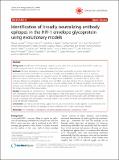Identification of broadly neutralizing antibody epitopes in the HIV-1 envelope glycoprotein using evolutionary models

View/
Author
Lacerda, Miguel
Moore, Penny L
Ngandu, Nobubelo K
Gray, Elin S
Murrell, Ben
Krishnamoorthy, Mohan
Nonyane, Molati
Madiga, Maphuti
Wibmer, Constantinos Kurt
Sheward, Daniel
Bailer, Robert T
Gao, Hongmei
Greene, Kelli M
Karim, Salim S Abdool
Mascola, John R
Korber, Bette TM
Montefiori, David C
Morris, Lynn
Williamson, Carolyn
Seoighe, Cathal
Note: Order does not necessarily reflect citation order of authors.
Published Version
https://doi.org/10.1186/1743-422X-10-347Metadata
Show full item recordCitation
Lacerda, M., P. L. Moore, N. K. Ngandu, M. Seaman, E. S. Gray, B. Murrell, M. Krishnamoorthy, et al. 2013. “Identification of broadly neutralizing antibody epitopes in the HIV-1 envelope glycoprotein using evolutionary models.” Virology Journal 10 (1): 347. doi:10.1186/1743-422X-10-347. http://dx.doi.org/10.1186/1743-422X-10-347.Abstract
Background: Identification of the epitopes targeted by antibodies that can neutralize diverse HIV-1 strains can provide important clues for the design of a preventative vaccine. Methods: We have developed a computational approach that can identify key amino acids within the HIV-1 envelope glycoprotein that influence sensitivity to broadly cross-neutralizing antibodies. Given a sequence alignment and neutralization titers for a panel of viruses, the method works by fitting a phylogenetic model that allows the amino acid frequencies at each site to depend on neutralization sensitivities. Sites at which viral evolution influences neutralization sensitivity were identified using Bayes factors (BFs) to compare the fit of this model to that of a null model in which sequences evolved independently of antibody sensitivity. Conformational epitopes were identified with a Metropolis algorithm that searched for a cluster of sites with large Bayes factors on the tertiary structure of the viral envelope. Results: We applied our method to ID50 neutralization data generated from seven HIV-1 subtype C serum samples with neutralization breadth that had been tested against a multi-clade panel of 225 pseudoviruses for which envelope sequences were also available. For each sample, between two and four sites were identified that were strongly associated with neutralization sensitivity (2ln(BF) > 6), a subset of which were experimentally confirmed using site-directed mutagenesis. Conclusions: Our results provide strong support for the use of evolutionary models applied to cross-sectional viral neutralization data to identify the epitopes of serum antibodies that confer neutralization breadth.Other Sources
http://www.ncbi.nlm.nih.gov/pmc/articles/PMC4220805/pdf/Terms of Use
This article is made available under the terms and conditions applicable to Other Posted Material, as set forth at http://nrs.harvard.edu/urn-3:HUL.InstRepos:dash.current.terms-of-use#LAACitable link to this page
http://nrs.harvard.edu/urn-3:HUL.InstRepos:13454709
Collections
- HMS Scholarly Articles [17922]
Contact administrator regarding this item (to report mistakes or request changes)


